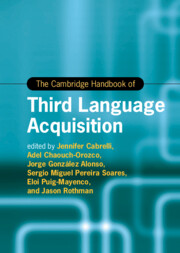Book contents
- The Cambridge Handbook of Third Language Acquisition
- Cambridge Handbooks in Language and Linguistics
- The Cambridge Handbook of Third Language Acquisition
- Copyright page
- Contents
- Figures
- Tables
- Contributors
- Introduction Multilingualism
- Part I Theoretical Approaches to L3/Ln
- Part II L3/Ln across Linguistic Domains
- Part III Becoming and Staying Multilingual at Different Ages
- Part IV L3/Ln in Action
- 16 Theoretical Linguistic Approaches to Multilingual Code-Switching
- 17 Psycholinguistics of Multilingual Code-Switching
- 18 Third Language Acquisition in the Classroom
- 19 Diversity in Multilingual Learners
- Part V L3/Ln and Cognition
- Part VI Research Methods in L3/Ln
- Index
- References
18 - Third Language Acquisition in the Classroom
from Part IV - L3/Ln in Action
Published online by Cambridge University Press: 13 July 2023
- The Cambridge Handbook of Third Language Acquisition
- Cambridge Handbooks in Language and Linguistics
- The Cambridge Handbook of Third Language Acquisition
- Copyright page
- Contents
- Figures
- Tables
- Contributors
- Introduction Multilingualism
- Part I Theoretical Approaches to L3/Ln
- Part II L3/Ln across Linguistic Domains
- Part III Becoming and Staying Multilingual at Different Ages
- Part IV L3/Ln in Action
- 16 Theoretical Linguistic Approaches to Multilingual Code-Switching
- 17 Psycholinguistics of Multilingual Code-Switching
- 18 Third Language Acquisition in the Classroom
- 19 Diversity in Multilingual Learners
- Part V L3/Ln and Cognition
- Part VI Research Methods in L3/Ln
- Index
- References
Summary
Teaching in multilingual classrooms requires careful consideration of the type of learners, their background languages, acquisitional paths and current usage patterns in those languages. Morphosyntactic features causing errors for some learners can be assets for others at the same time.
We begin by illustrating several different scenarios present with heterogeneous learners, as well as influential factors associated with the acquisition and teaching of multiple languages. Next, we focus on the existing models of morphosyntactic transfer in third language acquisition to be able to discuss how these can be applied to actual teaching in the third language classroom. Then, we discuss the role of contrastive analysis and review classroom-based and classroom-relevant implications for instructed third language acquisition. In conclusion, we outline corresponding teaching- and research-related calls for action and implications for language teaching in multilingual classrooms with the main goal of bridging the gap between these current fields.
- Type
- Chapter
- Information
- The Cambridge Handbook of Third Language Acquisition , pp. 466 - 491Publisher: Cambridge University PressPrint publication year: 2023



